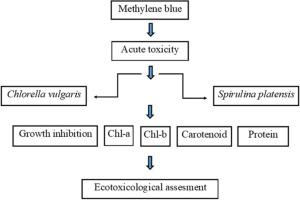Environmental Toxicology and Pharmacology ( IF 4.3 ) Pub Date : 2020-11-24 , DOI: 10.1016/j.etap.2020.103552 Abarna Krishna Moorthy , Bhuvaneswari Govindarajan Rathi , Satya Prakash Shukla , Kundan Kumar , Vidya Shree Bharti

|
Microalgae are ecologically important species in aquatic ecosystems due to their role as primary producers. The inhibition of growth of microalgae due to dye pollution results in an upheaval in the trophic transfer of nutrients and energy in aquatic ecosystems. Therefore, this investigation aimed to evaluate the toxicity of a textile dye Methylene blue (MB) on two microalgae viz. Chlorella vulgaris and Spirulina platensis. An exposure of the unialgal populations of both the microalgae towards graded concentrations of the dye showed a concentration-dependent decrease in specific growth rate, pigment and protein content. In the toxicity study of 24 –96-h, following the OECD guidelines 201, the EC50 values of C. vulgaris and S. platensis ranged from 61.81 to 5.43 mg/L and 5.83 to 1.08 mg/L respectively revealing that S. platensis exhibited a higher level of susceptibility towards the dye as compared to C. vulgaris and the latter is more tolerant to the dye toxicity even at higher concentrations. The findings indicate that the response to dye is a species-specific phenomenon. Given the differences in the cell structure and enzymatic pathways in Spirulina platensis (a prokaryote) and Chlorella vulgaris (an eukaryote), the tolerance levels can differ. After 96-h exposure of C. vulgaris to MB (100 mg/L), the chlorophyll-a, b and carotenoid content were reduced 2.5, 5.96 and 3.57 times in comparison to control whereas in S. platensis exposure to MB (10 mg/L), the chlorophyll-a and carotenoid content were reduced 3.59 and 5.08 times in comparison to control. After 96-h exposure of C. vulgaris and S. platensis to the dye (20 mg/L), the protein content was found to be 4.34 and 2.75 times lower than the control. The protein content has decreased in accordance with the increase in dye concentration.
中文翻译:

纺织染料亚甲基蓝对所选淡水微藻生长和代谢的急性毒性
由于微藻作为主要生产者,在水生生态系统中是重要的生态物种。由于染料污染而导致的微藻生长受到抑制,导致水生生态系统中营养和能量的营养传递发生剧变。因此,本研究旨在评估纺织染料亚甲基蓝(MB)对两种微藻的毒性。小球藻和螺旋藻。两种微藻的非藻类种群均对染料的分级浓度的暴露显示出比增长率,色素和蛋白质含量的浓度依赖性降低。在24 -96小时的毒性研究中,按照OECD指导201,EC 50值普通小球藻和钝顶链霉菌分别在61.81到5.43 mg / L和5.83到1.08 mg / L范围内显示,与普通鳞球菌相比,钝顶链球菌对染料的敏感性更高,甚至对普通染料的耐受性也更高。在更高的浓度。这些发现表明,对染料的反应是特定物种的现象。鉴于螺旋藻(原核生物)和小球藻(真核生物)在细胞结构和酶促途径上的差异,耐受水平可能会有所不同。将寻常衣藻(C. vulgaris)暴露于MB(100 mg / L)96小时后,叶绿素a,b与对照相比,类胡萝卜素和类胡萝卜素含量降低了2.5、5.96和3.57倍,而在链霉链霉菌暴露于MB(10 mg / L)中,叶绿素a和类胡萝卜素含量与对照相比降低了3.59和5.08倍。将寻常小球藻和钝顶螺旋藻暴露于染料(20 mg / L)96小时后,发现蛋白质含量比对照低4.34和2.75倍。蛋白质含量随着染料浓度的增加而降低。



























 京公网安备 11010802027423号
京公网安备 11010802027423号